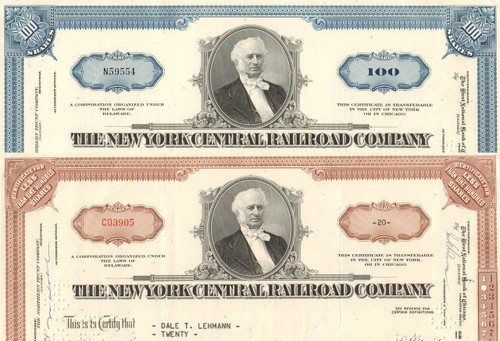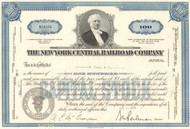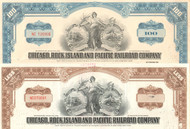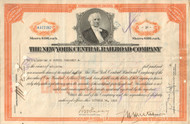Categories
Categories
- Home
- Stock Sets
- Company Sets
- New York Central Railroad Company 1960's - Set of 2 colors
New York Central Railroad Company 1960's - Set of 2 colors
Product Description
New York Central Railroad stock certificate set of 2 colors
Classic railroad piece with a lot of history. Perfect vignette of Cornelius Vanderbilt, the Commodore. Issued and cancelled, Dates in the 1960's. Affordable gift idea. This listing is for the two color set (blue, brown).
Set of 2 colors!
The New York Central Railroad operated in the northeastern and midwestern United States. Headquartered in New York City, the New York Central was a large railroad, and it had several subsidiaries whose identity remained strong in local loyalties.
In broad geographic terms, the New York Central proper was everything east of Buffalo plus a line from Buffalo through Cleveland and Toledo to Chicago (the former Lake Shore & Michigan Southern Railway). NYC included the Ohio Central Lines (Toledo through Columbus to and beyond Charleston, West Virginia) and the Boston & Albany Railroad. The Michigan Central Railroad was a Buffalo-Detroit-Chicago line and everything in Michigan north of that. NYC's Grand Central Terminal in New York City is one of its best known extant landmarks.
In 1968 the NYC merged with former rival Pennsylvania Railroad to form the Penn Central, which went bankrupt by 1970.
In 1851 the state passed an act freeing the railroads from the need to pay tolls to the Erie Canal, with which they competed; that same year the Hudson River Railroad was opened from New York City to Rensselaer and the New York & Erie (later the Erie Railroad) was opened from Piermont, on the Hudson River, west to Dunkirk, New York, on Lake Erie. The New York & Harlem Railroad (NY&H) was incorporated in 1831 to build a line in Manhattan from 23rd Street north to 129th Street between Third and Eighth Avenues. In 1844 the rails reached White Plains and in January 1852 the NY&H made connection with the Western Railroad .
On July 6, 1853, ten railroads stretching 298 miles from Buffalo to Albany were consolidated as the New York Central Railroad. The president of the new railroad was Erastus Corning, the former mayor of Albany and president of the Utica and Schenectady Railroad. By 1863 Cornelius Vanderbilt controlled the NY&H and had acquired a substantial interest in the Hudson River Railroad. In 1867 he obtained control of the New York Central, consolidating it with the Hudson River in 1869 to form the New York Central & Hudson River Railroad
The Watertown & Rome Railroad (W&R) was chartered in 1832 to connect Watertown, New York, with the Syracuse & Utica and the railroad opened in 1851, Meanwhile, NYC had built its own line north from Herkimer: the St. Lawrence & Adirondack (later Mohawk & Malone) . NYC merged the Mohawk & Malone in 1911 and the RW&O in 1913.
The NYC controlled the Buffalo & State Line and the Erie & North East Railroads by 1853; they were combined as the Buffalo & Erie in 1867. The Cleveland, Painesville & Ashtabula Railroad was opened between Cleveland and Erie in 1852. In 1868 the CP&A took its familiar name, Lake Shore, as its official name, and a year later it absorbed the Cleveland & Toledo and joined with the Michigan Southern & Northern Indiana to form the Lake Shore & Michigan Southern Railway . Cornelius Vanderbilt acquired control of the LS&MS during the business panic of 1873.
Boston and Albany maintained much more of its own identity than did other NYC subsidiaries. It had its own officers, and until 1951 its locomotives and cars were lettered "Boston & Albany" rather than "New York Central Lines," largely to appeal to local sensitivities.
The Ohio Central lines included the Toledo & Ohio Central Railway and three leased lines, the Zanesville & Western Railway, the Kanawha & Michigan Railway, and the Kanawha & West Virginia Railroad. It was renamed the Toledo & Ohio Central (T&OC) in 1885. The NYC acquired control of the T&OC by 1910 and began operating it as part of the NYC System. NYC leased the railroad in 1922 and merged it in 1952.
The Great Western Railway opened in 1854 from Niagara Falls to Windsor, Ontario, opposite Detroit, and in March 1855 John Roebling's suspension bridge across the Niagara River was completed, creating with the NYC a continuous line of rails from Albany to Windsor. Vanderbilt, who had started buying MC stock in 1869, tried to purchase the Great Western. He did not succeed and turned his attention instead to the Canada Southern Railway. It had been incorporated in 1868 as the Erie & Niagara Extension Railway to build a line along the north shore of Lake Erie and then across the Detroit River below the city of Detroit. He acquired the railroad in 1876; MC leased it in 1882. Conrail sold the Canada Southern to Canadian National and Canadian Pacific in 1985. NYC leased the MC in 1930.
The Terre Haute & Alton Railroad was organized in 1852; its backers were certain that with a railroad to Indiana the Mississippi River town of Alton, Illinois could easily outstrip St. Louis a few miles south. It soon combined with the Belleville & Illinoistown Railroad as the Terre Haute, Alton & St. Louis. The Indianapolis & St. Louis was organized to build between Indianapolis and Terre Haute, Indiana. It leased the St. Louis, Alton & Terre Haute, successor to the Terre Haute, Alton & St. Louis, and came under control of the CCC&I in 1882.
The New York Central System was the final name change, which took place in the summer of 1935. The NYCS was the largest of the eastern trunk systems from the standpoint of mileage and second only to the PRR in revenue. It served most of the industrial part of the country, and its freight tonnage was exceeded only by coal-carrying railroads. In addition it was a major passenger railroad — with perhaps two-thirds the number of passengers as the PRR, but NYC's average passenger traveled one-third again as far as PRR's
NYC did not share as fully in the post–World War II economic expansion because of rising labor and material costs and an extensive improvement program, especially for passenger services. Despite having several modern steam locomotives, NYC's poor financial position caused it to convert to more economical diesel-electric power rapidly. NYC also carried a substantial tax burden from governments that saw rail infrastructure as a source of property tax revenues — taxes that were not imposed upon interstate highways. The railroad was also saddled with a wartime–era tax of 15% on passenger fares, which remained until 1962.
The Central's archrival was the PRR. West of the Allegheny Mountains the two systems duplicated each other at almost every major point; east of those cites, the two hardly touched. Both railroads had physical plant not being utilized to capacity, but aggressive consolidation left NYC in better shape. PRR was worse than practically any other railroad, having four to six tracks where one or two would do - track that was no longer needed but which was still on the tax rolls. Differences aside, NYC and PRR announced merger talks in 1957.
Planning and justifying the merger took nearly a decade, during which time the eastern railroad scene had changed radically, in large measure because of the impending merger of NYC and PRR. The Erie merged with the DL&W to create the Erie Lackawanna Railway (EL) in 1960, C&O acquired control of B&O, and N&W took in the Virginian Railway, Wabash, Nickel Plate, Pittsburgh & West Virginia and Akron, Canton & Youngstown. Stockholders of the PRR and NYC approved the merger of the two railroads on May 8, 1962. ICC approved the merger four years later, and on February 1, 1968, the Penn Central (PC) came into existence — and fell apart faster than it went together.
 Loading... Please wait...
Loading... Please wait... 








